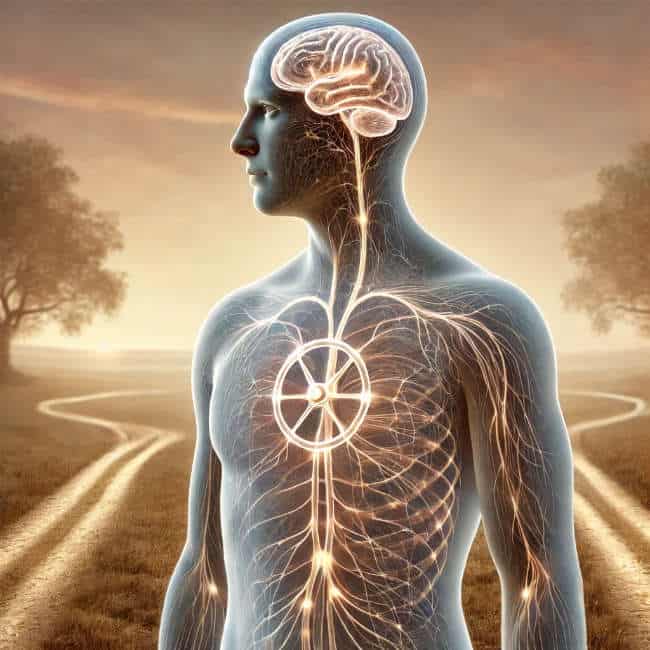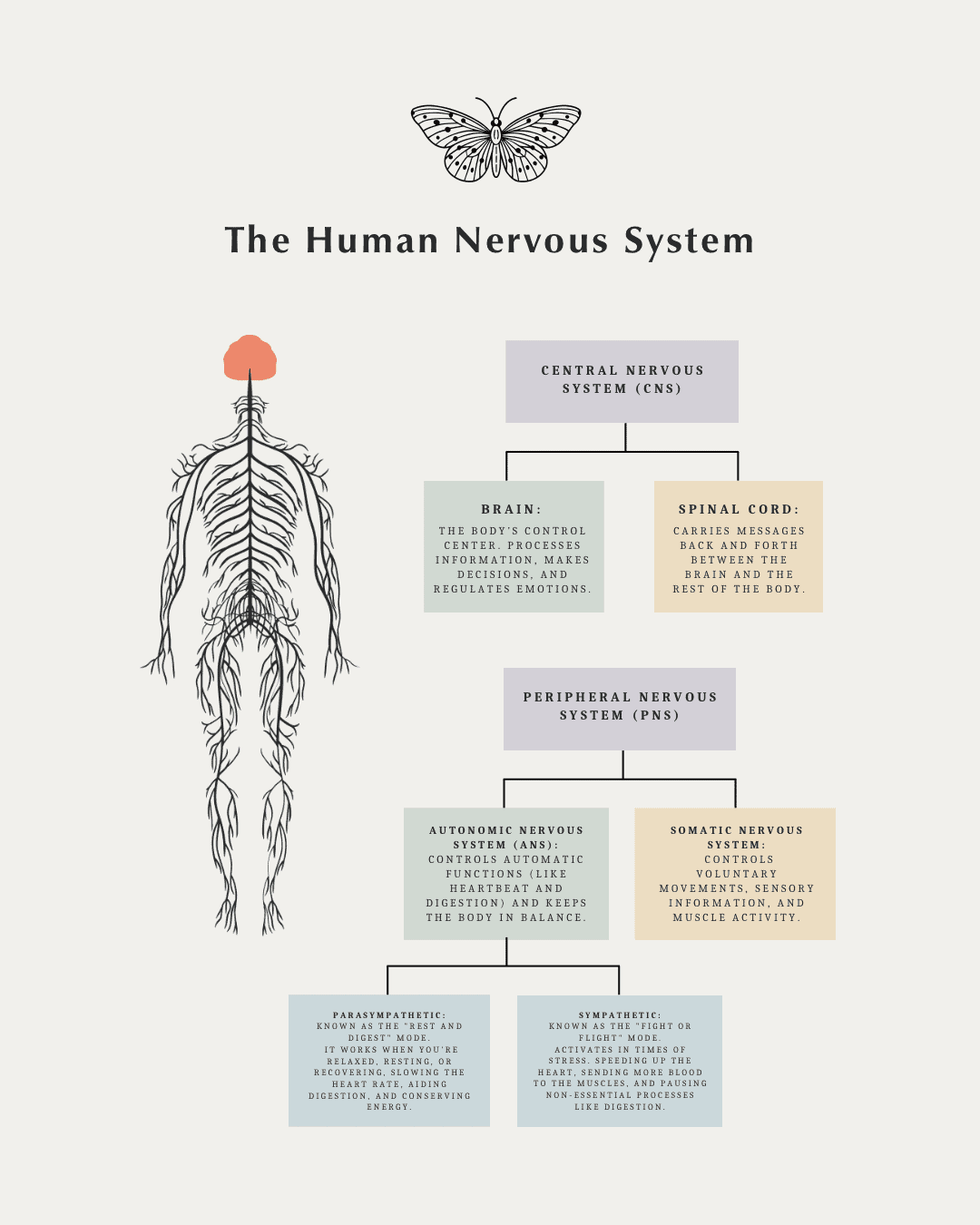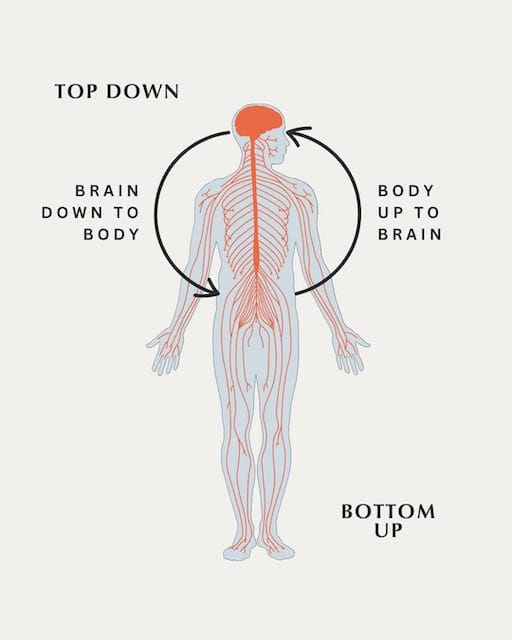Emotional Regulation Therapy
A Whole-Person Approach to Healing
Your nervous system is the key to your wellbeing
Neuroscience confirms that your nervous system is the foundation of all healing, it literally creates your entire experience of life. That’s why emotional regulation therapy is such a vital part of healing. it works with the nervous system directly, rather than around it.
If you’re not consciously in the driver’s seat, your system operates automatically, making decisions based on what it has learned from the past. It seeks safety.
Your autonomic nervous system lives in your body and shapes every part of your experience:
- Your thoughts, positive and negative
- Every sensation, racing heart, tension, nausea, or joy, connection, calm
- Every behaviour and action
- Your perception of yourself, of others, and the world around you
This is why thinking “I will get better” isn’t enough. You need to become friends with your body, to show, not tell, your nervous system that you are safe.

“You cannot think your way out of a dysregulated nervous system, you must show it through experience.”
The amygdala, part of your limbic system, constantly evaluates whether internal and external signals are safe or dangerous. If it senses danger, even when none exists, it triggers survival patterns:
- Anxiety or panic
- Physical symptoms and pain
- Shutdown or dissociation
Nervous System Regulation and Emotional Healing
Emotional regulation therapy is about increasing your capacity to sit with pain, stress, and life’s inevitable hardships, with more ease. This doesn’t happen overnight. It requires repeated evidence to your nervous system that safety exists.
Your protective responses, built from trauma, fear, and survival, have done an amazing job of keeping you alive. They served a purpose. Now, it’s time to let them relax and show them: it’s safe to be you.
Underneath all the layers of protection, you still live, whole, resilient, and capable. When you step into yourself, authentically, life feels alive again.
Safety + Connection = Thriving.
Working with Mind and Body
Your subconscious mind has immense power to heal, but only if fear and doubt are removed. To truly heal, we combine top-down and bottom-up approaches. This is the foundation of somatic emotional regulation.
Healing the Nervous System: Top-Down & Bottom-Up Approaches
When it comes to deep, lasting healing, especially from trauma, chronic illness, anxiety, or burnout, we need to work with the entire nervous system.
This means not just changing our thoughts (top-down), and not just calming the body (bottom-up), but combining both. This is where true transformation happens in emotional regulation therapy.
Why Is the Nervous System So Important?
All humans experience emotions. But not everyone is equipped with the essential life skills to process them or regulate their nervous system when stress builds. Everyday triggers, whether from work, relationships, or our internal world, can activate chronic stress patterns and protective behaviours that once served us but now leave us feeling stuck, disconnected, or overwhelmed.
This is where somatic therapy for emotional healing becomes essential. It gives us practical, body-based tools for building emotional intelligence and nervous system regulation. These tools aren’t just about coping, they’re about healing. They help us recognise what we feel, why we feel it, and how to move through it.
Emotional processing means learning to engage with emotional experiences, both the joyful and the painful, in a way that’s aligned with who we are. It’s more than reacting. It’s about understanding, integrating, and learning from our emotional life.
Emotional regulation is the ability to manage and respond to emotional experiences in a way that supports our wellbeing and relationships. It helps us stay grounded through life’s intensity and reconnect to ourselves when we’ve been thrown off course.
Your autonomic nervous system (ANS) plays a central role in this. It allows you to move between states of activation and calm. When you learn how your nervous system responds to stress and emotion, you gain a roadmap for resilience, one that brings greater peace, emotional stability, and trust in yourself.
Through body-oriented emotional regulation therapy, we begin to heal stored trauma, recalibrate the nervous system, and nurture lasting wellbeing.
Emotions are signals seeking acknowledgment. When we were not taught how to regulate emotions as children, when we were punished or shamed for feeling, we learned to suppress, avoid, or distract. These patterns follow us into adulthood. And they shape our choices, our health, and our relationships.

Without learning how to recognise and release emotions and the mental stories that fuel them, we remain trapped in survival-mode behaviours led by the nervous system.
But with awareness and support, we can shift this.
The Impact of Emotional Regulation Therapy:
- Mental Health and Resilience: Emotional regulation reduces anxiety, prevents burnout, and helps us respond to life with more steadiness.
- Trauma and Stress Release: By becoming attuned to the body’s “felt sense,” we start to access and release trauma stored in implicit memory. This is essential in any effective emotional regulation therapy.
- Improved Relationships: Emotional awareness strengthens our ability to communicate, empathise, and reduce conflict.
- Work-Life Balance: When you understand your nervous system, you develop boundaries and habits that bring ease to both personal and professional life.
“So much opens up when we stop fighting our emotions and start listening to them. This isn’t about being perfect. It’s about becoming present, one moment at a time.”
Understanding the Two Healing Paths
Your nervous system is your body’s command centre. It’s constantly scanning your environment to ask one simple question:
Am I safe?
If your system perceives safety, you feel calm, connected, energised, and present.
If it detects a threat (even a past or imagined one), it activates protective responses: fight, flight, freeze, or fawn.
Over time, these responses can get stuck, especially after trauma, chronic stress, or illness. This is why many people feel stuck in anxiety, disconnection, fatigue, or chronic pain… even when there’s nothing visibly “wrong.”
This is where trauma-informed healing and nervous system reset practices become essential.
Top-Down and Bottom-Up Healing in Emotional Regulation Therapy
Top-Down Healing
Top-down healing focuses on the mind influencing the body. This includes working with your thoughts, beliefs, and perceptions to shift your emotional and physical experience.
Examples of Top-Down Approaches:
- Hypnotherapy
- Cognitive Behavioural Therapy (CBT)
- Mindset coaching
- Meditation and mindfulness
- Visualisation / Guided imagery
- Brain retraining (e.g. DNRS, Gupta Program)
- Affirmations and belief work
These methods are incredibly effective in rewiring neural pathways, teaching your brain new ways to respond to life, and creating healthier emotional patterns.
But for many, top-down alone isn’t enough. That’s where bottom-up comes in.

Bottom-Up Healing
Bottom-up healing works by regulating the body to calm the mind.
It starts with felt experiences, movement, breath, sensation, to shift your biology first, which then changes your thoughts and emotions. This is the cornerstone of somatic emotional regulation.
Examples of Bottom-Up Approaches:
- Nervous system regulation
- Somatic therapy (body-based therapy)
- Breathwork
- Vagus nerve stimulation
- Dance or movement therapy
- Tapping (EFT)
- Touch, massage, or craniosacral therapy
- Grounding
This approach works with your body’s felt sense of safety, which can’t always be accessed through thinking. It’s especially powerful for trauma, where words often fall short.
Why We Need Both for Deep Healing
Healing isn’t just about changing how you think. And it’s not just about calming your body either.
You are a whole system, and your healing journey is too.
Top-down and bottom-up approaches are both necessary in emotional regulation therapy. The top-down work helps retrain your brain to think in healthier, more empowering ways. The bottom-up work helps regulate your nervous system so you can feel those new thoughts as truth in your body.
When we use both, we start to feel safe and think safe. We move out of survival and into thriving.
A Real-Life Example of Emotional Regulation Therapy
You tell yourself:
“I am safe now. It’s okay to relax.”
But your heart is racing, your chest feels tight, and your body doesn’t believe it.
That’s where bottom-up work steps in. With tools like grounding, breathwork, or somatic movement, you begin to regulate the body. The nervous system starts to shift. Then…
Your body begins to match your thoughts. You start to feel what safety really feels like.
This is when healing locks in.

Rewiring Your Experience Through Emotional Regulation
Your mind can fire up to 40,000 thoughts a day, 85% are negative, 95% are repetitive. The subconscious constantly searches for threats.
Conscious awareness is key to change that.
Focus on
- What you can do.
- What you can control.
- What is present.
What you focus on, you feel.
By shifting your attention to what’s right, no matter how small, you begin to cultivate hope, resilience, and presence.
Shifting Your Trajectory
Most people give up because they can’t imagine another way. But new pathways can be built with attention and intention.
Turn your attention from triggers to glimmers: the small moments of joy, peace, connection, gratitude.
- Train your brain to look for them, and they multiply.
- If thinking your way out worked, you’d already be well.
- You don’t need “fixing”, you need guidance.
Emotional regulation therapy and somatic work unlock different doors, and when we use them together, your healing becomes more grounded, more effective, and more sustainable.
No more “just thinking positive” and wondering why it’s not working. No more calming your body but still feeling stuck in fear.
Integration = Healing
Top-down (mind) + Bottom-up (body) = transformation.
By consciously teaching your body it’s safe through mindful awareness, movement, breath, and presence, you rewire your nervous system toward health, calm, and connection.
When you’re chronically stressed, your vibration dials down, making joy, ease, and expansion feel foreign. Reconnection through mind-body healing for stress brings you back.
Living Within the Window of Tolerance
Your optimal state lies between hyper-arousal (fight/flight) and hypo-arousal (shutdown).
Here’s a snapshot:
| Hyper-Arousal (Fight/Flight) | Window of Tolerance | Hypo-Arousal (Freeze/Collapse) |
|---|---|---|
| Heightened arousal | Emotional balance | Numbness, dissociation |
| Overwhelm | Rational thinking | Fatigue, emptiness |
| Impulsive reactions | Curiosity & calm | Shame, isolation |
When you’re in the window of tolerance, you’re emotionally safe, grounded, and connected. This is your pathway to resilience and wellbeing.
A New Way Forward
If you’re feeling disconnected from your body, from life, or even from hope, that’s okay. You don’t need to see the whole path right now. You just need a starting point.
Here’s where we begin:
- Understanding your nervous system and how it influences your health
- Noticing the small “glimmers”, those quiet moments of joy, ease, or peace
- Practising presence, even in the tiniest ways
- Learning how to be with your body, instead of against it
- Listening to your body with kindness
- Learning to identify and respond to body signals
- Creating safety in mind and body
It’s not about perfection. It’s about consistency, compassion, and courage. Gently step by step.
FAQ’s
Emotional regulation therapy helps you understand, manage, and respond to your emotions in ways that support your wellbeing. It focuses on calming the nervous system, healing stored stress or trauma, and building the capacity to stay grounded through life’s ups and downs.
Rather than focusing only on thoughts or past experiences, emotional regulation therapy includes the body. It combines mind-based tools (like hypnotherapy and belief work) with body-based practices (like grounding, breathwork, and somatic awareness) to help shift how you actually feel, not just how you think.
Not at all. This work is gentle, accessible, and doesn’t require any special skills. We start with where you are, offering practices that help your body feel safer over time, step by step, in a way that feels manageable.
Yes. Many people come to this work because they feel overwhelmed, anxious, disconnected, or emotionally reactive. By learning to regulate your nervous system and understand your emotional responses, you can begin to feel more steady, present, and in control again.
Each session is shaped around you. We might explore what your body is holding, identify protective patterns, practise gentle somatic techniques, or work with imagery and subconscious beliefs. It’s not about forcing change, it’s about creating space for healing to unfold.
I’m Here to Support You
My role is to walk beside you, to help you come home to yourself.
You will learn how to:
- Feel calm without needing to control everything
- Think clearly without spiralling out of control
- Connect to your body without feeling fear
- Move forward without having to force your way through
Through doing this, we cultivate presence, connection, hope, and resilience.
You Don’t Need to Be Fixed, You Need to Be Met With Care
So many of us were taught to believe that if we just tried harder or stayed more positive, things would change. But the truth is, healing isn’t about trying harder. It’s about being kinder, especially to the parts of you that are tired, scared, or stuck.
You are not broken. Your body is not your enemy. You don’t need fixing, you need support, understanding, and the right tools to reconnect with yourself.
This is whole-person healing.
Slowly, Together, We Rewire and Regulate
Whether you’re dealing with chronic stress, emotional pain, trauma, or simply feeling disconnected from yourself, there is a path forward.
And it begins with your nervous system.
Let’s gently teach your body and mind that it’s safe to heal. Let’s reconnect you with the grounded, empowered version of you that’s still here.
Your body already knows how to heal. Together, we’ll help it remember.
Ready to Begin?
If any part of this resonated with you, if you’re tired of feeling stuck in survival mode and are ready to feel grounded, safe, and connected again, I’d love to support you.
You don’t have to do this alone.
